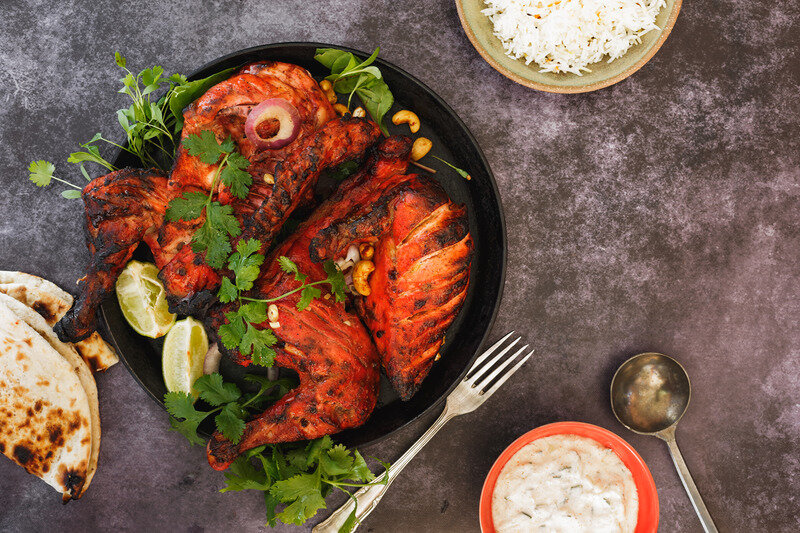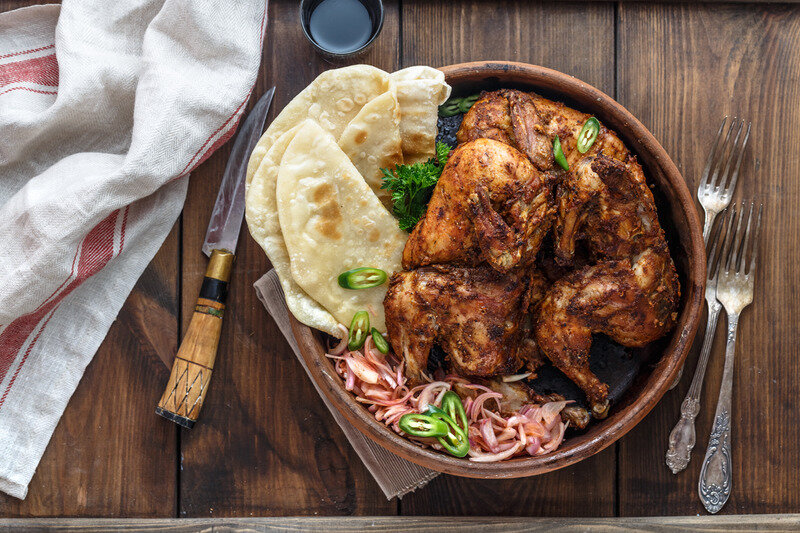Is Tandoori Chicken Healthy? (3 Tips for Weight Loss)
Tandoori Chicken is a unique type of chicken dish that utilizes yogurt as a way to marinate the chicken to make it super tender and special spices to bring out a smoky and spicy aroma.
Not only that, but Tandoori Chicken is also cooked in a special cylinder-shaped clay oven also known as a tandoor, hence the name of the dish.
Originating in India, countries, and states all over the world have taken from this special cooking method to make their own style of Tandoori Chicken.
Tandoori Chicken is absolutely delicious and is a unique type of chicken that everyone should try, but is it healthy?
Tandoori Chicken is not the ideal food when stating healthy as the dish is extremely high in fats with a smaller amount of protein. This encourages weight gain due to the excess fats which may lead to many complications.
However, this does not mean you can not eat Tandoori Chicken when you are on a diet as balance of macronutrients is still attainable with tracking.
In this article, we will be discussing three tips on how you can incorporate Tandoori Chicken into your diet while still losing weight:
Understanding the Nutrition Behind Tandoori Chicken
What to Eat with Tandoori Chicken
How to Make Your Own Healthier Tandoori Chicken
Tip 1: Understanding the Nutrition Behind Tandoori Chicken
Tandoori Chicken commonly uses skin-on chicken thighs and legs as the main ingredient of the dish.
With several different spices used to season the chicken and the plain yogurt used to marinate the chicken, this is not a complicated dish to make!
However, most recipes call for the chicken to be marinated in yogurt for up to 6 hours to give it the most flavor.
Let us take a deeper look at the nutritional information of a serving of Tandoori Chicken:
For every serving of Tandoori chicken, there are approximately 360 calories with 9 grams of carbohydrates, 22 grams of fat, and 32 grams of protein.
As you can see this chicken is relatively high in fat but also has a good amount of protein.
However, when we are eating a source of protein, we want to make sure that the fat to protein ratio is 1:3.
Even though there are fewer grams of fat than protein in Tandoori chicken, the overall food mainly consists of fat because fat is higher in calories compared to protein and carbohydrates.
Every gram of fat has 9 calories, whereas carbohydrates and protein only has 4 calories per gram.
This is why most people eat only around 50-60 grams of fat per day to prevent themselves from exceeding their total calorie intake needed to lose weight.
With Tandoori chicken being 22 grams of fat, this can be almost half the amount of fat you should be eating per day!
If you want to eat Tandoori chicken, I recommend eating half a serving which will put you at only 180 calories and only 11 grams of fat.
This is much more incorporable into your diet and will make your diet much more successful.
Tip 2: What To Eat With Tandoori Chicken
As we discussed in the paragraph above, if you cut your Tandoori Chicken in half, it will make it much easier to fit into your diet.
However, eating only half a Tandoori Chicken serving is probably not enough to satiate you for the rest of your meal, so what should you eat with your Tandoori Chicken?
Quite often, Tandoori Chicken is served with either naan or Indian rice but you also want to make sure you are not eating too much of these carbohydrate-dense foods.
You can definitely pair your Tandoori Chicken with some rice or naan bread, but you want to limit your consumption and make sure you are not going back for seconds.
Rice and bread are two foods that you can easily overeat when you are not being aware!
Another great replacement for rice is cauliflower. In fact, a lot of recipes recommend pairing your Tandoori
Chicken with some grilled or pan-fried cauliflower!
This is a great low-carbohydrate replacement that allows you to eat more voluminous food for less caloric intake.
There are so many recipes out there that teach you how to make cauliflower rice which is a nice alternative to rice.
However, if you want to eat just regular rice and do not like the taste or texture of cauliflower that is totally fine too!
As long as you watch your portion size and make sure you are not eating too many calories per meal, regular rice is easily incorporable into your diet.
The same thing goes for the naan bread which is an excellent pairing with your Tandoori chicken.
I recommend that you pair your Tandoori Chicken with a good portion of vegetables and greens such as broccoli, Brussel sprouts, or whatever leafy greens they have available on the table.
Vegetables are super low on calories and are fibrous foods that keep you full and satiated which prevent you from overeating.
Pairing your Tandoori Chicken with vegetables is a great way to have a complete meal that won’t leave you hungry and craving more food.
Tip 3: How to Make Your Own Healthier Tandoori Chicken
Tandoori Chicken is typically made with skin-on chicken thighs and legs to make the juiciest and most tender meat possible, but as we saw earlier, it is a difficult food to incorporate into your diet.
The good news is that you can make a much healthier version of Tandoori chicken that still tastes delicious.
The Meat
Instead of using chicken thighs and legs, if you replace the meat with chicken breast instead, this significantly reduces the amount of fat and calories in the overall dish.
Although it might not be as tender, chicken breast marinated correctly can still be cooked to make it not as stiff.
You also want to make sure you are using skinless chicken breast because the skin contains a lot of additional fats and calories.
By purchasing skinless chicken breast, you can eat a much healthier dish that is higher in protein and lower in fats.
Chicken breast is an excellent lean source of protein that is one of the most ideal foods to eat when you are trying to lose weight.
Here is our recipe for a Tandoori Chicken recipe you can eat when trying to stay healthy!
For every 100 grams of chicken breast, it is only 160 calories with only 4 grams of fat, 31 grams of protein and no carbohydrates.
This is 200 calories less than the Tandoori Chicken that utilizes chicken thighs and legs!
There are way fewer grams of fat in the chicken breast which is why it is so much lower in calories making it a great lean source of protein.
The Yogurt
Although the recipe calls for plain yogurt, a great alternative to use is Greek non-fat yogurt. Greek non-fat yogurt is a great source of protein that is super low in calories and does not contain any fat.
Replacing your yogurt with Greek yogurt can significantly lower the number of calories in the overall dish!
Greek yogurt also adds an excellent tangy flavor to your dish so you will not be compromising the overall taste of your Tandoori Chicken.
Make sure that you are purchasing Greek NON-FAT yogurt and not just plain Greek yogurt. Plain Greek yogurt has a lot more fat per serving whereas Non-fat Greek yogurt has none, making it significantly lower in calories.
The Seasoning
If you are afraid of adding additional calories from seasoning, don’t be!
Seasonings are extremely low in calories so it will not be detrimental to your diet.
Many seasonings are less than 5 calories per teaspoon so it is a great way to add flavor and aroma into your food.
You want to make your diet as enjoyable as possible, and eating bland food without any seasoning can be a very painful diet.
Tandoori chicken calls for multiple spices to give it its unique flavor and cutting it out can really affect the overall taste.
Seasoning is a wonderful alternative to heavy sauces, which are usually very high in calories if you are not careful, so do not be afraid to spice up your foods with your favorite seasoning!
Now you know how to make a healthier version of your own Tandoori Chicken as well as how to portion size when you are eating out, you can easily incorporate Tandoori Chicken into your diet!
As long as you are watching how much you are eating throughout the day, your weight loss journey does not need to involve you cutting out certain foods from your diet.
By making sure you do not eat too much and maintain a calorie deficit, this should be a maintainable lifestyle.
CONCLUSION
Remember, although nutrition is a huge factor that influences weight loss, it is important to pair this journey with exercise as well.
Especially strength training.
Several years of research on the benefits of weight training have shown that individuals that do some sort of consistent resistance training at least 3-5 times a week have shown not only a great amount of weight loss but are also able to keep the weight off!
The secret to this phenomena is that strength training leads to a build-up of muscle.
Not only does your body recomposition into a more fitting and athletic-looking aesthetic, but having more muscle also increases your resting metabolic rate which essentially means you burn more calories at rest!
Now that we know the importance of muscle we need to make sure we stay on track with our workouts.
Consistency and longevity are the two key factors when building muscle so there will be some commitment involved.
We understand that not everyone has access to a gym membership or feels comfortable starting off in such an intimidating environment.
Although I would strongly recommend that everyone should get a gym membership, don’t worry we got your back!
You can either go to the gym or build one for yourself.
It really just comes down to 3 pieces of equipment that you need to do most workouts.
These three are the workout bench, dumbbells, and gym flooring.
Check out our recommended gear page to see our best picks for these pieces of equipment here.
https://www.aspirefitnesswalnut.com/home-workout-equipment
If a home gym is not for you then getting a membership somewhere works too.
As long as you are starting your muscle-building journey, we’re happy!
Stick with it for the long run and you’ll see how amazing the results can be.
RECENT POSTS
The Asian Weight Loss Cookbook
The 15 Fat Burning Meals Cookbook features our favorite recipes that you can use to get closer to your fitness goals.
Become your own personal trainer with the guidance of this book and make this the year you achieve your insurmountable fitness goals.
PHILLIP PAK
Phillip Pak is a fitness expert who has been training clients for 6 years. Throughout his fitness journey, Phill has done it all when it comes to diet and nutrition. He is now the owner of Aspire Fitness Walnut where his main goal is to help those who are seeking to find the best version of themselves. Phillip is also a NASM Certified Nutrition Coach (CNC) and a NASM Certified Personal Trainer (CPT).














